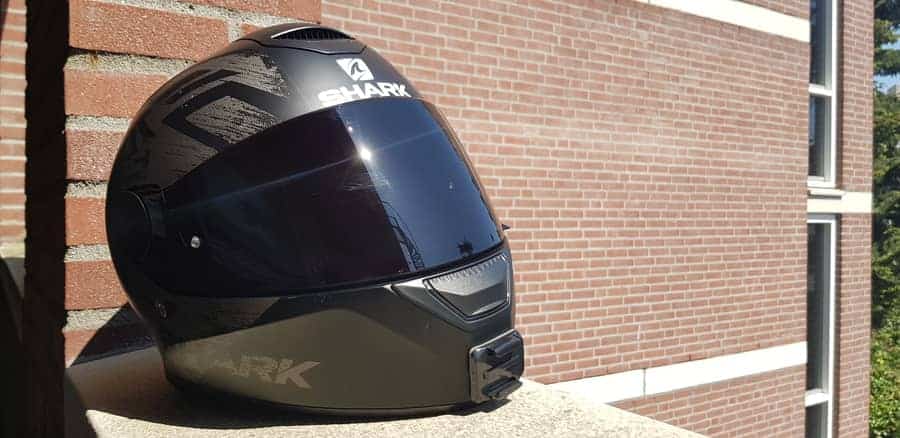Motorcycle visors catch a lot of dirt, bugs, and dust on the road. After a few thousand kilometers of riding, you’re going to need to clean and maintain your visor. But helmet visors and the chemical coatings on them are extremely sensitive. How do you clean your helmet visor without damaging it? Let’s find out.
When to wash your helmet visor
Generally, you should wash your helmet visor each time it gets dirty, but what exactly is dirty? A “dirty” helmet visor is subjective but a general rule of thumb is washing it each time you clean out your helmet’s liners. If the visor looks cloudy or if the objects seem to be blurry behind your visor, that may also be a good time to give it a wash.
Visors are close to the eyes and sometimes dirt can be hard to see. I remember a time when I thought my helmet visor was still clean because I can still see clearly while I was riding. It was only after I washed it when I realized how dirty it had been. The ride after cleaning the visor was similar to upgrading my cable subscription to high definition channels! It felt like a whole new world.

How to wash your helmet visor
The market may be full of cleaners, polishes, and coatings for your helmet, but because helmets sometimes come with ultraviolet coatings or anti-fog coatings, a lot of riders agree that the best way to clean a helmet is still with good old-fashioned warm water. This will minimize any damage to the sensitive coatings on the visor.
To get started, you will need:
- Warm water
- A small basin
- Three (or more) microfibre cloths
- Liquid soap or baby shampoo (optional)
The actual cleaning process is quick and simple but there are a few things you should take note of before you start rubbing away dirt and bugs from your visor. Dust and dirt particles, as well as bugs, are abrasive. Rubbing them may cause the dirt and insect parts to scratch your visor.
Step 1:
The best first step is to get your microfibre cloth, dampen it, and simply drape it over your helmet visor. This will allow the abrasive hard dirt and insect exoskeletons stuck on your helmet and visor to soak up and eventually soften. Leave the wet cloth on your visor for five to ten minutes to make sure the dirt really softens up.
As you soak your visor, you can fill up a small basin with warm water. Warm water would be preferred as this would be the best for the sensitive coatings that your helmet may have. A few drops of liquid soap would theoretically be harmless but even warm water alone would do just fine.
Step 2:
Once you take off the cloth, you may notice that some of the dirt could have already dissolved. Take your helmet visor and dip it into the basin full of warm water. Take another clean microfibre cloth and gently rub the visor. Treat your visor as if it were thin and brittle glass. Don’t rub it too hard and if there are spots with dirt still sticking, carefully rub it with minimal pressure making sure not to cause scratches. Dirt comes off eventually, scratches stay forever.
Step 3:
Take your visor out of the water and take another microfibre cloth to dry it. This would also be a great time for you to inspect your visor. Hold your visor to the light to look for large scratches or deep gashes that can restrict visibility. This would ensure that you aren’t wasting your time cleaning a helmet that needs replacing.
Step 4:
Dry your visor with a clean microfibre cloth. You don’t need to rub it excessively to dry it. Just get some of the excess water off the visor. It doesn’t have to be 100% completely dry either because helmet visors should just be left to air dry. Once you get the excess water off, set your visor in a cool area away from sunlight.
If you don’t want water streaks drying up or if you want to dry up your visor quickly, you can use a blow dryer. Just remember to see it to the lowest setting and if there’s an option for cool air, use that.

And that’s it. You now have a cleaner visor. You may think that the process was too simple and easy. That’s because it is. Don’t be alarmed by the lack of cleaning products as some visor cleaners and polishers actually bring more harm than good. At least with water, you can be sure you won’t be damaging anything.
For those of us who have money to spare and still want to use cleaners on their visors, there are a lot of helmet visor cleaners on the market, but be wary. A lot of helmet manufacturers advice against cleaning your visor with any solution that contains ammonia because this may weaken the visor’s hard coating.
That being said, a lot of riders swear by Plexus Plastic Cleaners’ (Amazon) ability to restore scratched visors. Plexus is a combination of an abrasive compound and a wax which smoothens out scratches on a visor and at the same time leaves a thin wax coating for protection.
Some riders might tell you to skip all the marketing nonsense and just use toothpaste to clean your visor. Toothpaste is much more abrasive than any of visor cleaner on the market and would actually leave deep scratch marks on your visor. I learned that the hard way.
Want to learn more about helmet cleaners and polishers? Check out Ryan’s video on Fortnine. He talks about the best product for restoring a helmet/motorcycle visor.
Fogging and water repellants
Nothing beats the physics-defying anti-fog capabilities of a pin-lock insert, but if your helmet isn’t pin-lock ready, shaving gel would work fine. Shaving gel is actually one of the best fog repellants. It just doesn’t last as long. Also, shaving gel with menthol works best.
When it comes to keeping the water away from your line of sight, National Cycle Rain Zip (Amazon) works almost as good as a pair of windshield wipers on your visor. They’re a bit expensive, though.
Maintaining your helmet visor
Afraid that your newly washed helmet would get dirt on it the moment you start riding again? Just carry a pack of baby wipes with you! These are great for spot cleaning on your helmet on the fly. A baby’s skin is extremely sensitive to chemicals so baby wipes are made with mild and gentle substances, perfect for your helmet visor too! Baby wipes are already damp so they’ll do a great job softening up whatever is sticking onto your visor.
